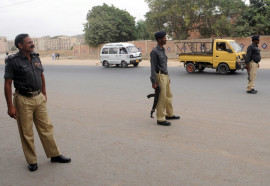
On Thursday the court ordered government officials and the administration of a school built on the same site as a century-old temple to allow members of the Hindu community to visit the place of worship freely.
The order came on a petition filed by Reejho Mal, a member of the Hindu community. He had taken the provincial chief secretary, culture secretary and the school’s administration to court for allegedly blocking the Hindu community’s access to the place of worship - Amrapur Asthan of Prem Prakash Panth.
This site, which is spread over seven acres, houses a historic temple and a samadhi - or final resting place- of Swami Teenu Ram Maharaj, who had laid down the foundation of ashrams or Hindu spiritual centres. The petitioner’s lawyer, Shahab Sarki, said that the samadhi and the temple are important religious places visited by devotees from across the country and abroad.
“Because of the law and order situation during the late 1950s, most Hindu families fled the area,” said Sarki. “The provincial government allotted a portion of the temple’s land to the education department, which established Dr Ziauddin Primary School there.”
The petitioner alleged that the school’s administration, particularly the headmaster, was hostile towards members of the Hindu community. He had not been allowing members of the minority group to enter the place of worship and perform rituals. Mal claimed that in October last year, the school’s administration had manhandled visiting Hindu pilgrims and did not let them enter the holy place, adding that a hostile group was also desecrating the sacred structures.

Sarki said that applications were sent to the authorities, asking them to ensure that Hindu community members get access to the temple and declare it as a protected heritage building. “Article 36 of the Constitution ensures right of free access to one’s worship place without any hindrance from the other,” argued Sarki. “Since this place bears historical and archaeological importance, it must be declared as protected heritage under Section 6 of the Sindh Cultural Heritage (Preservation) Act 1994.”
The counsel pleaded the court to declare that it was illegal for the school’s administration to prevent members of his community from practicing their religion by blocking access to the temple.
Later on, a social welfare organisation also joined the proceedings, claiming that a temple did not exist at the site. Muhammad Azam Qureshi, the organisation’s representative, alleged that the school was built at a spot on which a guest house comprising between 40 and 50 rooms once stood. He had pleaded to the court to dismiss the petitioner’s claim.
After hearing the arguments, the bench, headed by Justice Maqbool Baqar, ordered that by March 13, government official and the school’s management should ensure that Hindu community members can enter the temple freely. The provincial law officer was ordered to submit comments of government officials by this date.
Published in The Express Tribune, March 2nd, 2013.



1722413973-0/BeFunky-collage-(16)1722413973-0-165x106.webp)










1737618478-0/Express-Tribune---News-Desk-(9)1737618478-0-270x192.webp)








COMMENTS
Comments are moderated and generally will be posted if they are on-topic and not abusive.
For more information, please see our Comments FAQ